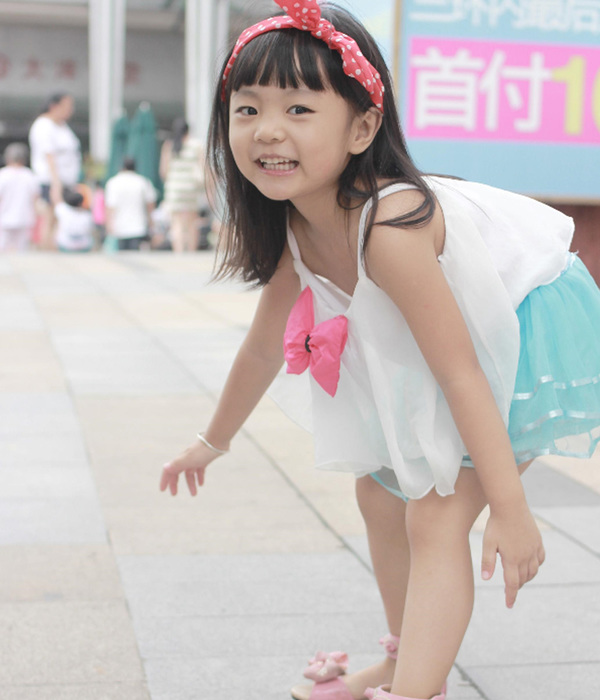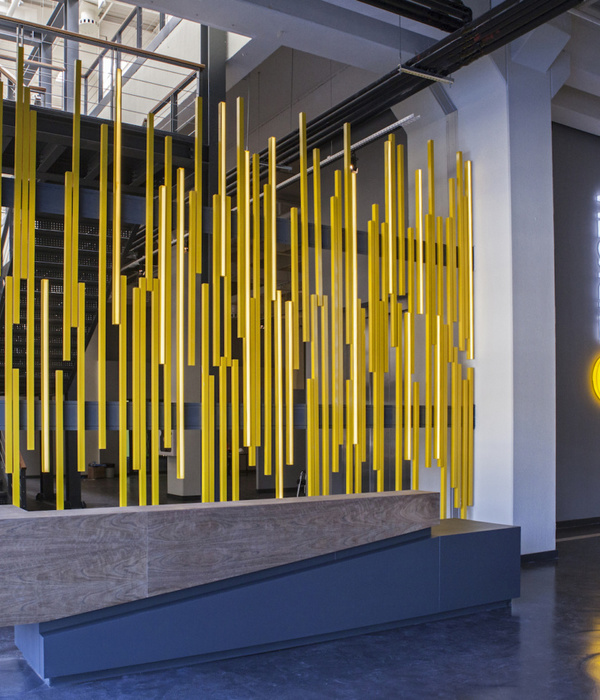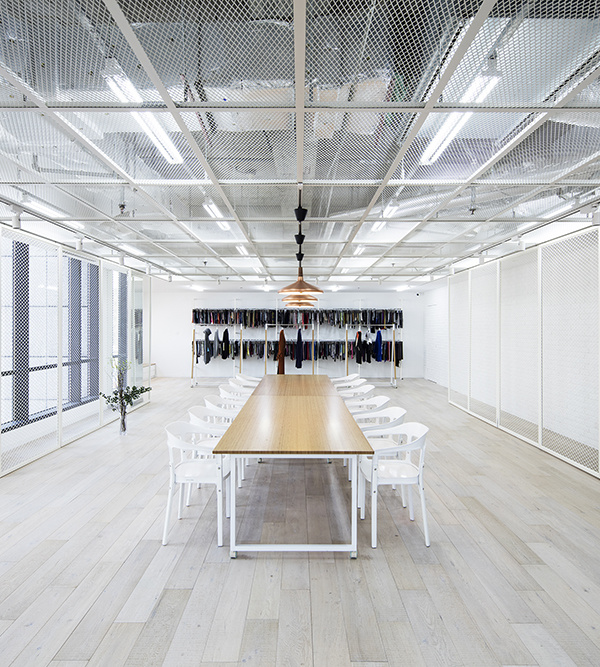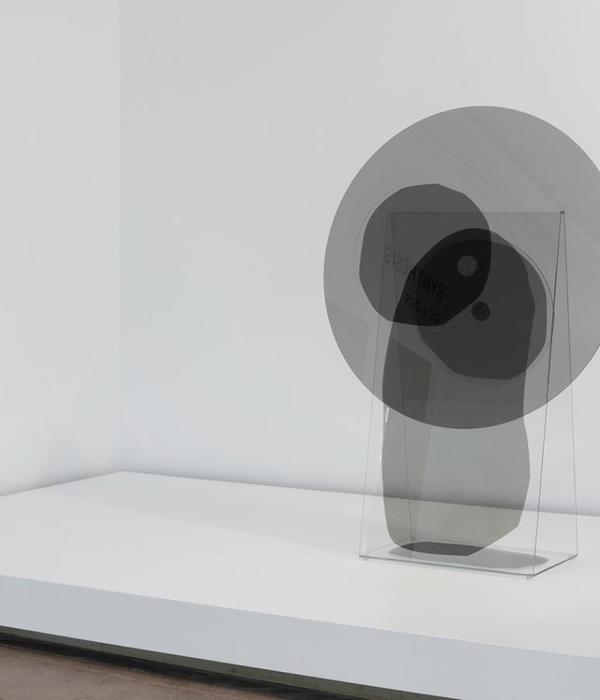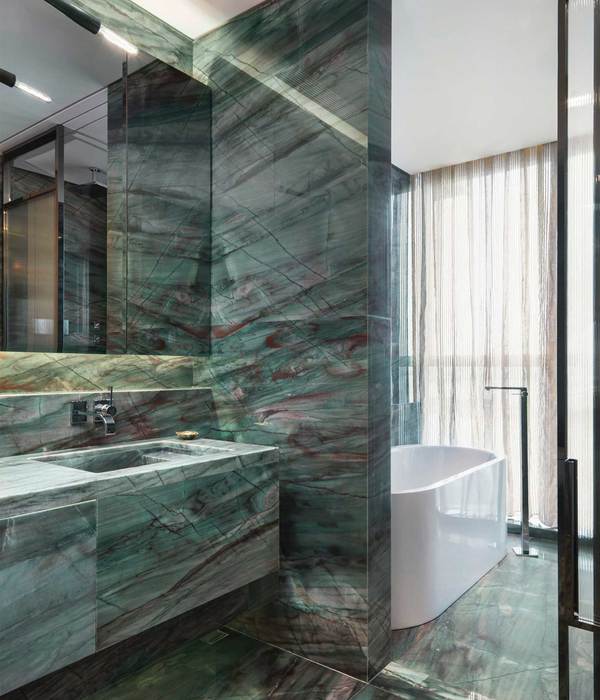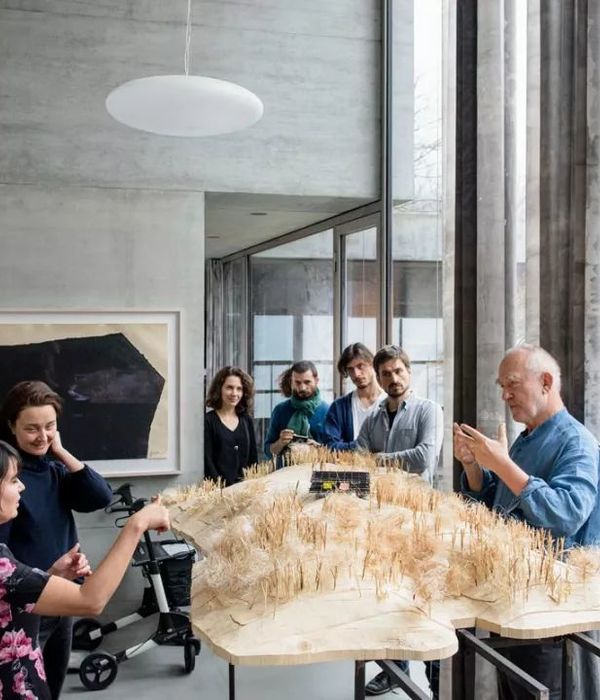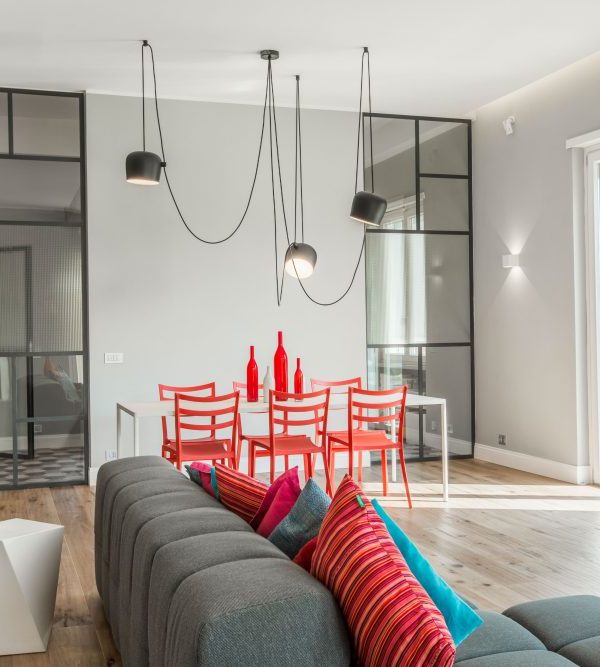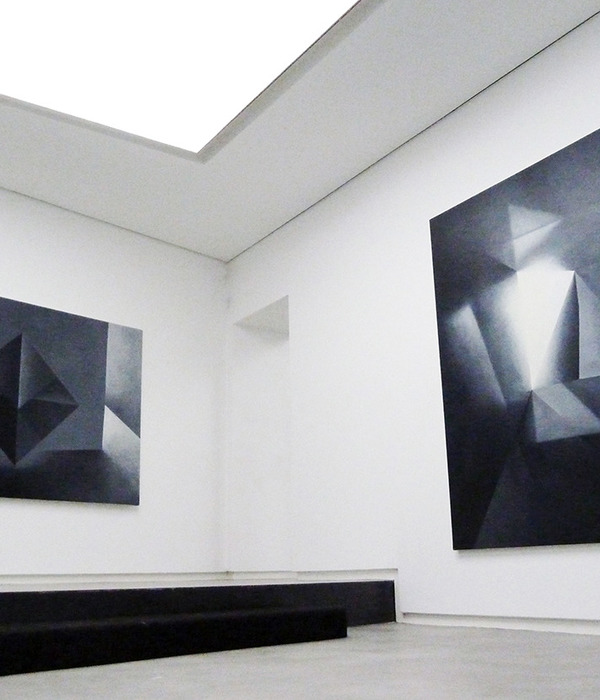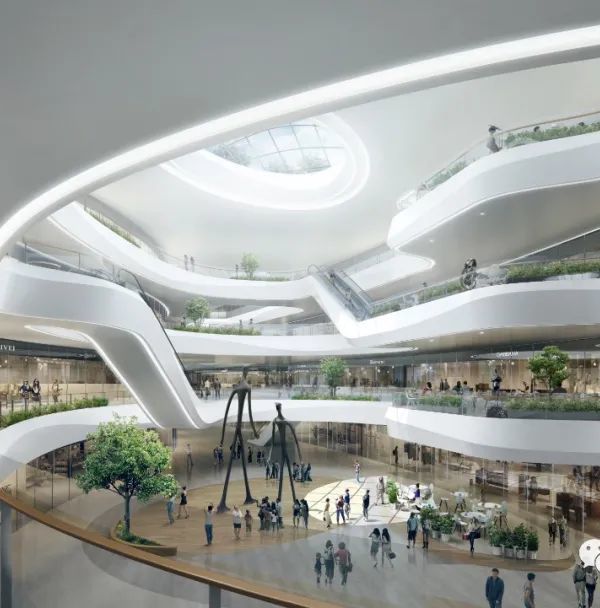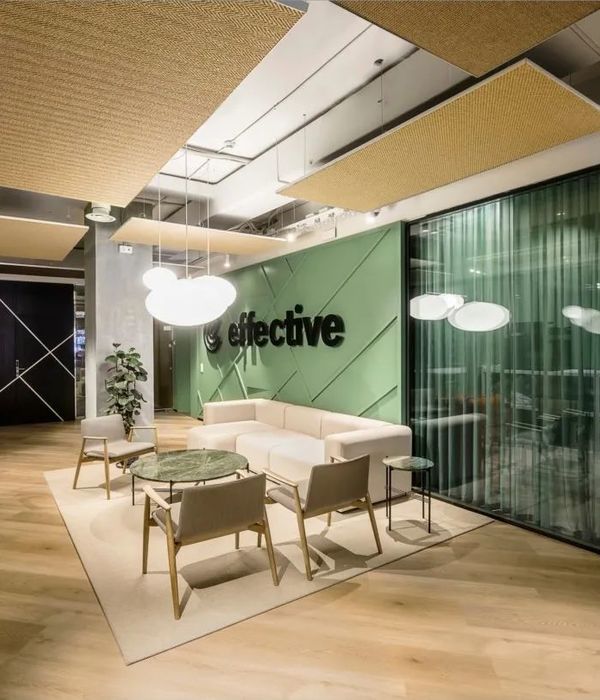The Police headquarters has three buildings. Two of the old cavalry buildings, representing over two thirds of the existing buildings, have been kept and renovated to a low energy standard. The existing space has not been significantly changed, the refurbishment of these zones therefore highlights and preserves such spaces as the generous layout or the high ceilings.
To the North (D wing) and the East (E wing) of the site the two long buildings built in typical regional brick architecture house part of the police offices. Associated services (cafeteria, event area) and the Fine Arts Museum exhibition rooms are located in the wider areas of the old stables that have been preserved on the ground floor.
Since the renovation of these two buildings was not sufficient to meet the requirements of the programme a third building was imagined : A 75 metre high cylindrical, elliptical tower, a new urban landmark echoing the Charleroi City Hall belfry. The tower, of which the shape is intended to be welcoming, is encased in blue brick, a reminder of the colours of the police force.
Composed of a reinforced concrete structure and a wood facade covered in brick, it meets the criteria for a passive building as defined by the authorities.
From the tower lobby, which is the only way in through its large volumes, staff and visitors walk to the different departments using a « link tunnel » architecture connecting the three buildings.
Access to the car parks, the detention centre and the logistics centre is via the ramp at the rear of the site in rue Spinois. In the new tower the design is as flexible as possible, allowing to modulate the space depending on needs and changes over time: each level can easily switch uses in order to favour relations between different police departments.
There is a three level underground car park beneath the tower, but also the detention area, the archives and other storage areas. To the rear of the ground floor a debriefing room has been installed and on the first floor there is an auditorium for lectures and conferences.
The third level is reserved for premises that require a technical service floor: dispatching, IT services, crisis centre. It is occupied night and day and is the true heart of the building. The highest level houses a prestige meeting room with a panoramic view over the city.
In the old parts the qualities of the existing areas have been preserved : very wide corridors with offices arranged along only one side.
The offices are modular within the existing load bearing wall structures. Cloakrooms have been installed on two levels in the cavalry barracks E wing. The cafeteria is in D wing and occupies a generous area in one of the two old stables.
The new architecture creates a new geography with its heart marked by a large public square directly accessed from Boulevard Mayence. The North and East sides are composed of the old buildings, the street runs along the West side and Charleroi Danses is on the South side.
Behind the two renovated buildings a space between the buildings and the beautiful brick surrounding wall has been created. This space is used for vehicle access, deliveries and access to the car parks to the rear of the site and frees up the public square from the constraints of the old parade ground.
This freely accessible new square is an area which each and everyone can appropriate. Only police cars and bicycles are allowed to cross it in order to provide a maximum of freedom for pedestrians.
All can come here attracted by its many functions, from the brasserie at the heart of the square to the Fine Arts Museum exhibition rooms in one of the renovated wings which will shortly be installed by the City. This new square is paved in red brick, criss-crossed with blue bricks around the tower in order to connect the new Police headquarters to the historical buildings.
The old cavalry training ring called « Les Écuries » houses the Choreography centre for the Fédération Wallonie-Bruxelles Charleroi Danses.
This space is inhabited by a « village » atmosphere created by a succession of small brick buildings linked by interior paths.
The human dimension and the « village » atmosphere that encourages conviviality have been kept and strengthened by new small buildings similar to the existing ones and spread along the inner pathways.
The extension of Charleroi Danses includes the design of an atrium providing easier access and a new and even more convivial lobby, there are three levels of dance studios and housing for the resident artists.
The main entrance, which is flanked by two large bays and designed by Lhoas and Lhoas brothers the renowned Belgian architects, has been kept and maintained on the Boulevard Mayence. This space is now visible from the street and has street level access topped by an atrium that can also be seen from the street.
At the reception area a staircase and elevators lead to the overhanging level that houses the access to the Charleroi Danses hall and offices as well as to the upper lobby level. The large dance studio has been kept to a size close to that of the existing stage. It is behind a brick wall that runs along the street to the place de la police and benefits from natural daylight through a large bay of east facing windows. It has access from reception, the atrium and from the boxes-cloakrooms.
A new access to the show theatre has been created at the upper balcony level : it allows the public to discover the entire space at a glance. A small and light metal construction with 2.80 metre high windows, the lobby sits like a nomad tent on the terrace formed by the slab of the big dance studio. It is covered by a fabric on which the Charleroi Danses logo has been printed like a modern signal.
The terrace is open on three sides : the street, the « village » and the square. It thus plays on the ambiguity of the closeness of the police and the dancers. The mobile bar can be installed in the lobby or on the terrace. The two small dance studios have been built on the rear part of the site in a separate building that is nevertheless a part of the « village ». It has a twin sloping roof.
Natural light pours in through large bays of windows in its facades. It is all covered by a micro-perforated fabric on which a photomontage of shows produced by Charleroi Danses has been printed to remind of the creative function of this area.
The cloakrooms, which have been installed in the basement, connect the ground floor « large studio » to the basement « small studios » by a direct staircase.
Recent buildings were demolished along the surrounding wall, between the police lot and the existing older building that houses the prop workshop. Independent and protected housing for resident artists has been created in this cleared area. It has been built along the same lines as the existing buildings : a small brick and glass building.
Hôtel de Police et extension de Charleroi danses (fra)
FRA - Un repère dans la ville Un site déjà marqué par un bâti datant du XIXe siècle, la caserne de cavalerie occupée depuis longtemps par la gendarmerie. Comme de nombreuses friches investies par un programme culturel, l’ancien manège est occupé par une troupe de danse contemporaine internationalement reconnue. Un programme de regroupement de tous les services pour compléter la fusion de la police et de la gendarmerie, et de plus l’extension de Charleroi Danses…
PLAN DE SITUATION L’hôtel de police Notre proposition est de créer une image publique et accessible de la police, de dégager une place ouverte vers la rue, vers la ville, et un bâtiment repère sur ce site ainsi libéré. Pour dégager le site, il faut d’abord démolir toutes les petites annexes qui furent construites au fil des ans à flanc du porche. On dégage ainsi la grande cour de « manoeuvres » en la rendant directement accessible depuis la rue : c’est la place publique. Les deux corps de bâtiments de l’ancienne cavalerie sont de beaux édifices tout en longueur, tout en briques, abritant deux larges espaces d’écuries au rez-de-chaussée : ils méritent d’être conservés, ce seront les deux premières ailes du projet. Derrière ces deux bâtiments, un large espace, puis un mur d’enceinte en briques : cette configuration permet de faire circuler l’ensemble des voitures, livraisons, parkings à l’arrière du site, entre le bâti et le mur, libérant totalement la place publique de ces contraintes. Le programme est important, la surface demandée est grande. Les deux corps de bâtiment conservés couvrent à peine un tiers de la demande. Il faut créer une troisième aile pour l’ensemble : elle sera verticale. Les trois ailes sont reliées au rez-de-chaussée, par l’intermédiaire d’un hall où s’effectuent tous les contrôles nécessaires à la sécurité du fonctionnement du programme. Pour la tour, la proposition faite est celle d’un immeuble d’une grande flexibilité et compacité où l’on peut, très facilement, changer d’affectation les niveaux ou les relations entre les services. Pour les bâtiments existants, c’est un lieu où l’on cherche à utiliser les qualités du bâti : peu de modifications dans les principes des espaces existants pour conserver leurs qualités spatiales : distribution généreuse, belle hauteur sous plafond… Il s’agit avant tout de la constitution d’un repère dans la ville. La tour qui s’élève n’est pas trop haute pour ne pas être impressionnante. Pour jouer comme une réponse au beffroi de l’Hôtel de ville, elle sera limitée à environ 75 mètres. Elle est de forme elliptique, pour la rendre conviviale. La couleur du logo de la police est bleu foncé : c’est cette couleur qui va habiller la tour. Cela va permettre une appropriation rapide du bâtiment par la population. La place est pavée de briques comme l’environnement ancien, de grandes bandes de couleur bleue peintes sur le sol vont lier la tour avec la place. Cette place est active : les piétons sont dirigés vers l’auvent qui marque l’entrée, les voitures d’urgence policières sont autorisées à circuler, les vélos aussi, c’est un lieu vivant de la ville. Charleroi Danses La place est bordée au Nord et à l’Est par le bâti ancien, à l’Ouest par la rue et au Sud par Charleroi Danses. Les locaux de Charleroi Danses sont caractérisés par un esprit « village » donné par une succession de petits bâtiments en briques desservis par une voirie intérieure. Cette atmosphère est propice pour garder une échelle humaine, par exemple lors d’événements type spectacles de rues… Cet esprit village sera conservé et continué en introduisant les nouveaux programmes sous forme de bâtiments du même type que l’existant distribués le long de la voirie intérieure : petits bâtiments de briques abritant les logements d’artistes et les studios de danse. Le lieu conservera son identité paisible et créative. L’entrée a été faite par des architectes belges reconnus, Lhoas et Lhoas, et nous proposons de la conserver : on conserve le mur d’enceinte et les grandes baies qui ont été percées pour accéder à la salle. Cependant l’accès est aménagé de plein pied avec la rue pour inviter le promeneur à pénétrer à l’intérieur, attiré par un atrium en transparence sur la rue sur toute la hauteur de la baie. Une baie vitrée sur la façade opposée de l’atrium laisse deviner la continuité du site en surplomb. Le grand mur de briques qui longe la rue est conservé : il devient la façade sur rue du grand studio de danse, accessible depuis l’atrium et depuis les loges-vestiaires. Un nouvel accès dans la salle de spectacle est aménagé au niveau du balcon haut de la salle : ceci permet au public de découvrir l’ensemble de la salle par le haut en entrant au spectacle. Ce nouvel accès est aussi le niveau du Foyer. Sur la terrasse formée par la dalle haute du grand studio de danse, petite construction légère, le Foyer est posé comme une tente nomade renvoyant à la vie des artistes, à la légèreté des danseurs. Sur la bâche qui recouvre cette tente, le logo et la typo de Charleroi Danses sont imprimés, signal contemporain. La terrasse est ouverte sur trois côtés : la rue, le village, et la place. Jouant avec l’ambiguïté de la proximité de ces deux programmes (Police / Danse).
{{item.text_origin}}

